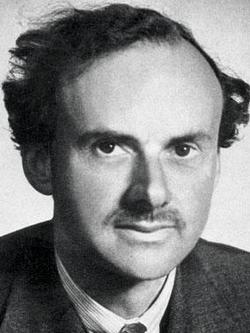


Paul Adrien Maurice Dirac (; 8 August 1902 – 20 October 1984) was an English mathematical and theoretical physicist who is considered to be one of the founders of quantum mechanics. Dirac laid the foundations for both quantum electrodynamics and quantum field theory. He was the Lucasian Professor of Mathematics at the University of Cambridge, a professor of physics at Florida State University, and a 1933 Nobel Prize in Physics recipient.
Dirac graduated from the University of Bristol with a first class honours Bachelor of Science degree in electrical engineering in 1921, and a first class honours Bachelor of Arts degree in mathematics in 1923. Dirac then graduated from the University of Cambridge with a PhD in physics in 1926, writing the first ever thesis on quantum mechanics.
Dirac made fundamental contributions to the early development of both quantum mechanics and quantum electrodynamics, coining the latter term. Among other discoveries, he formulated the Dirac equation in 1928, which describes the behaviour of fermions and predicted the existence of antimatter, which is one of the most important equations in physics, and is regarded by some physicists as the "real seed of modern physics". He wrote a famous paper in 1931, which further predicted the existence of antimatter. Dirac shared the 1933 Nobel Prize in Physics with Erwin Schrödinger for "the discovery of new productive forms of atomic theory". He was the youngest ever theoretician to win the prize until T. D. Lee in 1957. Dirac also contributed greatly to the reconciliation of general relativity with quantum mechanics. His 1930 monograph, The Principles of Quantum Mechanics, is one of the most influential texts on quantum mechanics.
Dirac's contributions were not restricted to quantum mechanics. He contributed to the Tube Alloys project, the British programme to research and construct atomic bombs during World War II. Dirac made fundamental contributions to the process of uranium enrichment and the gas centrifuge, and whose work was deemed to be "probably the most important theoretical result in centrifuge technology". He also contributed to cosmology, putting forth his large numbers hypothesis. Dirac also anticipated string theory well before its inception, with work such as the Dirac membrane and Dirac–Born–Infeld action, along with other contributions important to modern-day string and gauge theories.
Dirac was regarded by his friends and colleagues as unusual in character. In a 1926 letter to Paul Ehrenfest, Albert Einstein wrote of a Dirac paper, "I am toiling over Dirac. This balancing on the dizzying path between genius and madness is awful." In another letter concerning the Compton effect he wrote, "I don't understand the details of Dirac at all." In 1987, Abdus Salam declared that "Dirac was undoubtedly one of the greatest physicists of this or any century . . . No man except Einstein has had such a decisive influence, in so short a time, on the course of physics in this century." In 1995, Stephen Hawking stated that "Dirac has done more than anyone this century, with the exception of Einstein, to advance physics and change our picture of the universe". Antonino Zichichi asserted that Dirac had a greater impact on modern physics than Einstein, while Stanley Deser remarked that "We all stand on Dirac's shoulders." Dirac is widely considered to be on par with Sir Isaac Newton, James Clerk Maxwell, and Einstein.
Source : Wikipedia